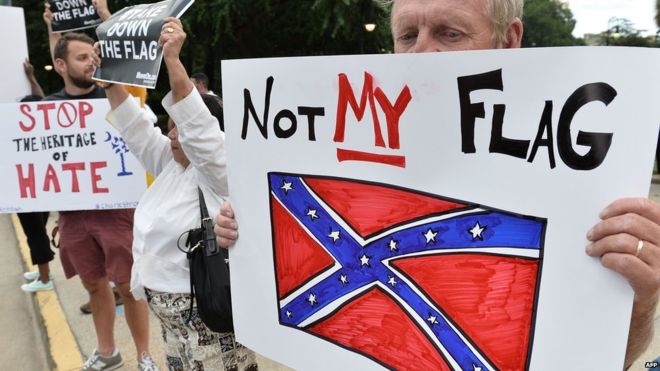[title maintitle=”” subtitle=”What it means for Muslims, blacks, Latinos, and women in America”]
Almost two months ago, the South Carolina Highway Patrol honor guard lowered the Confederate flag from the state’s Capitol grounds. As controversy rages on with bills and protests across the nation, it’s worth returning to Louis Farrakhan’s declaration in late June that we should lower the American flag too. “What flag do the police have?” Farrakhan said. “What flag flies over the non-Justice Department? What flag flies over the White House?”
One can supplement Farrakhan’s diatribe with references to American history and contemporary politics. While I’m not advocating Farrakhan’s position, it leads to questions that help us understand the stakes for marginalized groups like Muslims, blacks, Latinos, and women in America.
If you’re not self-consciously a white supremacist, your argument for the Confederate flag is to claim it as a symbol of Southern heritage or states’ rights, not slavery. For a moment, let’s forgive that the battle flag at the South Carolina Capitol wasn’t the original Confederate flag and that, if it were, the Confederacy it represents explicitly seceded because of slavery, even if it did have to do with states’ rights.
You can still cite the late Howard Zinn, who argued that the Civil War was about the economic interests of the northern elite more than “slavery as a moral institution.”
As a Confederate flag-bearer, you can say you’re moving beyond the horrors of your past, reforming your heritage to forge new cultural ground.
In fact, this is what most liberal Americans might say about the American flag: It doesn’t represent the horrors of their past but something essential about their culture, that they can remake America, that its society will eliminate evils with each step through the progress of history.
By this logic, the Confederate flag doesn’t have to represent slavery any more than the American flag should represent a drone strike to a village boy in Yemen.
Any version of the Confederate flag will likely incite disgust, fear, or anger for most reasonable Americans. But why doesn’t the American flag elicit the same feelings? What is it about the Confederate flag that says it cannot also transcend its origins? How do we distinguish between what is essential to each flag and what we can discard?
The Charleston church shooting that triggered all this brings to mind the recent, numbing string of hate crimes. The liberal response to these tragedies often focuses on progressive changes in policy related to policing, surveillance, Second Amendment rights, or hate speech.
This feels inadequate. What I found most shocking in the Trayvon Martin case, like its counterparts, was the insistence by both defense and prosecuting attorneys that race was not a considered factor.
Being black, Latino, Muslim, or one of several other groups sets you apart from a white male in America. The police are more likely to surveil, stop, frisk, and arrest you; the TSA will search you first; your employment opportunities are trying if not limited, especially if you speak your mind; and school systems are structured against you (consider the de facto segregation of the as-yet-unresolved Sheff v. O’Neill). As Sherman Jackson wrote in Islam and the Blackamerican, “To approach American society without the clue of race is to produce nursery rhymes.”
For Trayvon, the legal tenet of impartiality prevented any consideration of context. Law is famously lauded as colorblind, but this principle failed to address realities on the ground. For all intents and purposes, no one is truly equal under the law. Structures in law enforcement, economy, and education complicate the contexts by which we assume equality.
These are the same structures that perpetuate women’s lower average salary, that limit opportunities in education or the workplace, that let maternity leave rewind careers, that mishandle (or don’t handle) cases of rape, that objectify women in media even when they’re heroines. These grievances are part of a history of marginalization. They show gender-blindness is as dangerous as colorblindness.
So the blindfolded Lady Justice, a fundamental representation of law as impartial, does not live up to the hype. The problem is not about what bills Congressmen pass through the Senate and House Floors about policing, surveillance, guns, hate speech, abortion, or equal pay.
The problem has to do with structures, not their parts. With the idea of politics, not policies. With law, not laws.
Shortly before his death, Dr. Martin Luther King, Jr. remarked:
I’ve come upon something that disturbs me deeply. We have fought hard and long for integration, as I believe we should have, and I know that we will win. But I’ve come to believe we’re integrating into a burning house.
Structures like the state, modernity, globalism, or liberalism are considered abstract. But here, in this ongoing climate of violence and security, hate and indifference, patriarchy and liberal values, I cannot think of a time in which these abstractions—with their inconsistencies and inadequacies—are more real or more pressing.
It’s easy to dismiss what I’m saying as militant, anarchist, or both. I assure you, it is neither. This is a commonplace response that reveals a dearth in our social imagination and a self-defeating assumption that society always governed itself like this and always will. That this is how we operate as a species.
In this way, it feels as though conversations about systematized injustice are one-dimensional. Either you want to assimilate or integrate, follow the law or break it, engage peacefully or violently, remove the Confederate flag or don’t, label a rapist for life or acquit. Either there’s law or chaos.
As in the post-apocalyptic locomotive from the film Snowpiercer, we ride up and down a single train of thought. The rebels in the rear fight their way to the front, and those in the front work to keep “all things in their place.” But the train is claustrophobic, drab, and doomed to run out of steam. Only one character believes there is a habitable world outside the train and is willing to blow out the side to get there.
Like that character in Snowpiercer, we need to challenge ourselves as members of our communities to imagine the impossible, to imagine ways of living beyond what we know, and to imagine ways of getting there. We can look to history and we can look to stories. What we have is not working.
[separator type=”thin”]
Haris A. Durrani (@hdernity) is author of the forthcoming novella Technologies of the Self (Brain Mill Press) and an M.Phil. candidate in the History and Philosophy of Science at University of Cambridge. He holds a B.S. in Applied Physics and a minor in Middle Eastern, South Asian, and African studies from Columbia University, where he was an Egleston Scholar and co-founded The Muslim Protagonist Symposium. His published fiction, memoirs, and essays explore personal narratives at the nexus of law, technology, and disenfranchised identities, particularly in Latino and post-9/11 contexts.
[separator type=”thick”]
Photo Credit: AFP
Demonstrations at Columbia, South Carolina in June, prior to the removal of the Confederate battle flag from the state capitol. The Washington Post has documented at least 173 Confederate flag rallies nationwide since the Charleston massacre. Photo courtesy of AFP.





